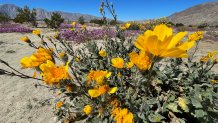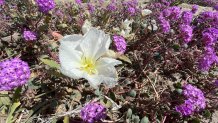The deserts of San Diego County are alit with wildflowers.
Record rains have fallen over most of San Diego County, and as of recently, the same is true of the desert.
It's been an unusual bloom in the Anza-Borrego Desert State Park. Why? Uncommon summer monsoons in September of last year triggered the first fall blooms, pulling blankets of violet sand verbena up over the desert dunes, according to Jim Dice, Reserve Manager at the University of California, Irvine's Steele/Burnand Anza-Borrego Desert Research Center in Borrego Springs.
Get top local stories in San Diego delivered to you every morning. >Sign up for NBC San Diego's News Headlines newsletter.
Dice has spent the last 30-odd years living in and studying the desert.
As of March 3, Anza-Borrego's rainfall total for the current period has reached 6.53 inches, surpassing its average annual yearly rainfall of 5.32 inches, Dice said. Plus, yearly numbers aren't tallied up until July.
So is the current bloom anything to write home about?
"I would say it's definitely better than average," Dice said.
"It's been a strange year and we, at the very western edge here of the Colorado Desert, Sonoran Desert, only occasionally get summer monsoons of any real strength and we did this year," Dice added.
The last time substantial summer monsoons fell were in 2013 and 2014.
"This is unusual in that it got started in September. There was a follow-up storm on October 15th that was only four-tenths of an inch, but that's pretty substantial for out here and it was enough to carry things that had germinated. We had a really miserable November and December," Dice said.
Top Stories on NBC 7 San Diego
Desert lilies began blooming this past December, and sand blazing stars in January, which are both unheard of.
"It's hard to say what's normal anymore. I've been here for 30 years and I really can't tell you what's normal. Every year seems to be different," Dice said, laughing.
How Much Longer Will the Blooms Last in the Desert?
It all depends on future rainfall.
A wet January and February kept the blooms coming. But the upcoming months are usually the driest. Warmer, drier days could dispel more blooms.

What is a 'Super Bloom' Anyway?
Dice prefers not to use the term "super bloom." Why is that?
It's a term that originated with the media and the chamber of commerce, Dice said. It's not something that is either quantifiable or even defined.
The California Department of Parks and Recreation prefers to call these events "rare and unpredictable wildflower blooms."
These types of blooms happen when high amounts of rain are combined with yearslong drought, which has already taken away much of the natural landscape's weeds and grasses, leaving more nutrients for wildflowers to grow.
What Flowers to Look For
Spot these blossoms while you're out:
- Sand verbena
- Evening primrose
- Desert sunflower
- Bigelow's monkeyflower (which can increase their size by three times during wet years)
- Blazing star (bloomed in January, which is unheard of)
- Bristly gilia
- Chinchweed

Many of these flowers are seen only in late winter and early spring, but have bloomed earlier than usual, during fall and winter, Dice said.
Fall visitors to the park would have noticed a rare and spectacular bloom of the short, yellow chinchweed plants.
"They regularly see [chinchweed] in places like Phoenix and Tucson because they get regular summer rainfall. We only see it occasionally over here and this year it was really spectacular," Dice said
"But true to its form, it came during late summer and by early to mid-fall, it was done," Dice added.
Water is no overlooked resource in the desert. Recent rains are benefitting desert cottontails, jackrabbits, coyotes, big horn sheep and vegetation.

Where to Find the Desert Blooms
- Along Henderson Canyon Road between Borrego Valley Road and Highway S-22
- First mile of Coyote Canyon
- Southern end of the park starting in June Wash, which is a sandy, four-wheel drive road located on highway S-2
- Check here for updates on bloom locations and printable flower maps
The desert wildflowers even have their own hotline! Call the Wildflower Hotline at 760-767-4684 to check for updates on where and when to find the florals.
How to Be a Respectful Steward of the Desert
- Do not pick the flowers: Picking flowers on National Forests, Parks or Monuments is illegal without a permit. Flowers exist so the plant can reproduce. Removing flowers from annuals (plants that bloom only once a year) means the plant's seeds will not be planted, and will not grow during the next wildflower season.
- Stay on the trails: Stepping on wildflowers and vegetation can kill them and going off trails can contribute to soil erosion. Habitat alteration can decrease the number of flowers.
- Park respectfully: Pull off the roads when viewing wildflowers or taking photos. Always leave roads clear for traffic.
- Make yourself known: Offer a friendly "hello" or an amiable head nod to hikers you encounter. This helps to create a friendly atmosphere on the trails, the National Park Service says. If approaching from behind, let other hikers know in a calm tone that you want to pass.
What to Know Before You Go
- Bring a lot of food and water: There aren't many restaurants, gas stations or stores near the desert blooms. Hydrate before your trip and stay hydrated throughout.
- Research and plan your trip: You'll want to see the best flowers in the best places. Check Anza-Borrego's Facebook page for updates on where flowers are blooming.
- Print or download a map: Cell service is not dependable in the desert. When in Anza-Borrego, go analog.
- Watch the weather: Conditions can change quickly in the desert. Wear a hat and lather on plenty of sunscreen.
If You Can't Make it to the Desert, Find Blooms Here
- Torrey Pines State Natural Reserve
- Cuyamaca Rancho State Park
- Mission Trails Regional Park
- The Flower Fields at Carlsbad Ranch
- Anywhere the blooms are sprouting. You might not have to travel far to see how San Diego County's chaparral can light up in colorful florals.



